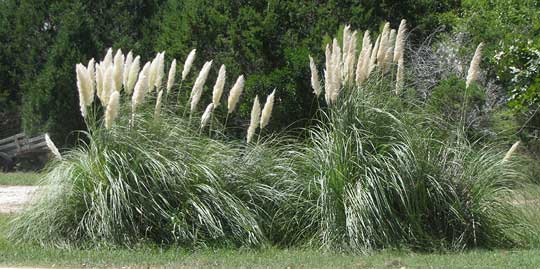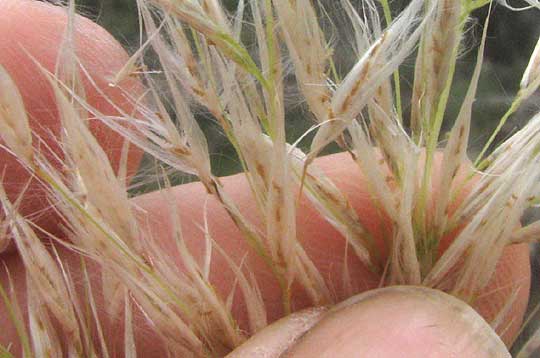Excerpts from Jim Conrad's
Naturalist Newsletter
from the September 9, 2012 Newsletter issued from the valley of the Dry Frio River in northern Uvalde County, southwestern Texas, on the southern border of the Edwards Plateau; elevation ~1750m (~5750 ft); N29.62°, W99.86°; USA
PAMPAS GRASS ON THE DRY FRIO
Just below the cabin on a little gravel island barely rising above the Dry Frio River's ankle-deep water grows the eight-ft-tall (2.5m) grass shown below:

Anyone familiar with popular landscaping plants will recognize this as Pampas Grass, CORTADERIA SELLOANA, but most of us never see Pampas Grass growing in the wild, unless we visit its homeland in South America. The Pampas Grass in the picture surely got established when the wind carried a tiny, white-parachuted fruit from my neighbor's much taller and more robust plants exactly in front of the cabin's driveway, shown below:

In Argentina and southern Brazil Pampas Grass grows naturally along streams and other low, wet areas, so here along the Dry Frio a wayfaring fruit has managed to find just what it needs.
A close-up some Pampas Grass spikelets is shown below:

A feature separating Pampas Grass spikelets from those of, say, the bluegrasses or fescues, is their very long pairs of glumes -- glumes being the silvery, long-pointed items at the base of each spikelet. The glumes are much longer than the collection of florets themselves, which is a little unusual. These special grass terms are explained on our grass page at http://www.backyardnature.net/fl_grass.htm.
Pampas Grass produces unisexual flowers, usually on different plants but sometimes flowers of both sexes occur on the same plant. It's easy to know that the flowers in the picture are female, because Pampas Grass's male flowers lack the long hairs that give these flowers a fuzzy appearance.
Pampas Grass has been reported as an invasive growing wild at several locations in Texas, but the species doesn't seem to be populating large areas like some weedy species.